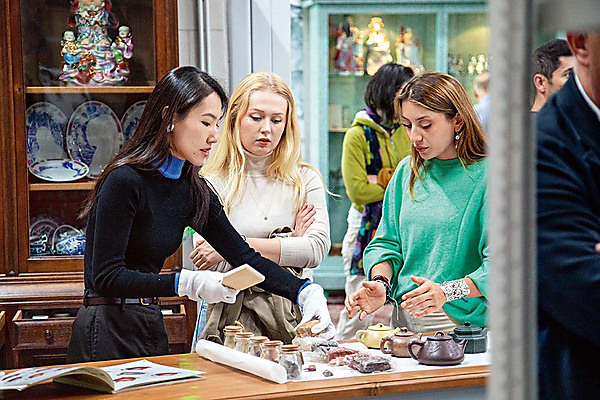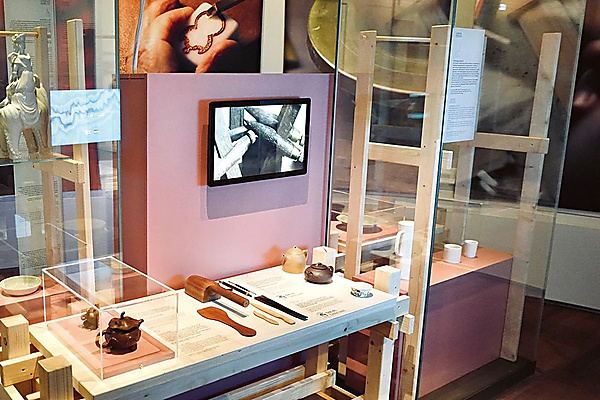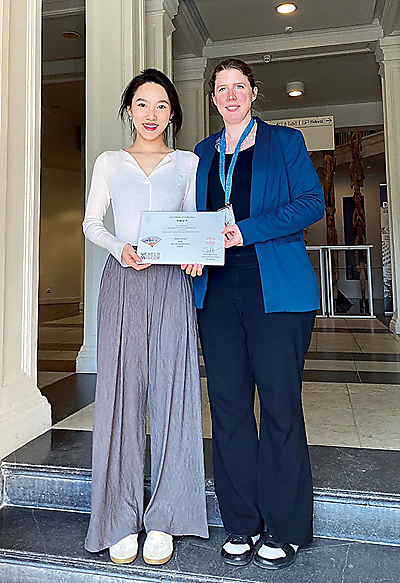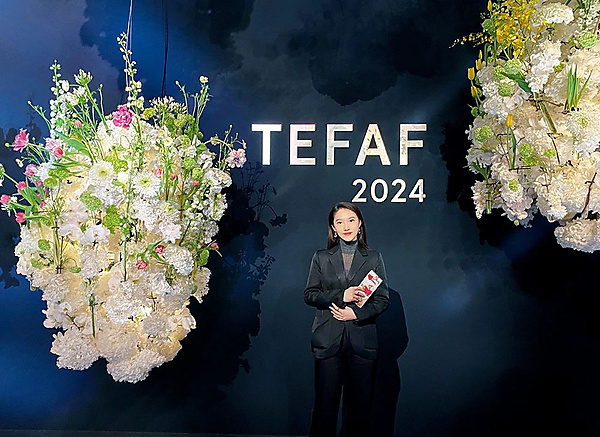Hu Xuan is a native of Yixing, a city in east China's Jiangsu Province. Yixing is well-known for its exquisite purple clay teapots. Out of her love for Chinese culture, and the culture of Yixing purple clay teapots, Hu founded a cultural-communication company, under which she created her brand, One·Pot. Hu is dedicated to spreading Chinese intangible cultural heritage, especially the culture of Yixing purple clay teapots, in the Netherlands. She is also committed to promoting communications and exchanges between various cultures.
Organizing Exhibitions
Yixing, rich in both tea and purple clay, is known as China's pottery capital. Hu often visited local museums, especially those that highlighted purple clay teapot culture, when she was in primary school. Hu has many relatives and friends engaged in purple-clay-teapot-related businesses, and those connections have heightened her interest in purple clay teapots.
Purple clay (also known as zisha) is the raw material for making Yixing purple clay teapots, which are well-known across China. Teapots made from purple clay retain the aroma of the tea leaves better, and the teapots enhance the taste of the tea.
In 2021, Hu obtained a master's degree, in contemporary art practice and curation, from St. Joost School of Art and Design, Avans University of Applied Sciences, in Den Bosch, the Netherlands. A year and a half later, she earned a second master's degree, in cultural economics, from Erasmus University Rotterdam, in Rotterdam, the Netherlands.
While studying in the Netherlands, Hu discovered many of the locals were interested in Chinese art. So, she decided to curate exhibitions, with Chinese art as the theme, to help the Dutch better understand China, and Chinese culture. The exhibitions were popular.
 |
| Hu Xuan (left) talks with visitors during an exhibition. |
Once, Hu gave a presentation, about making purple clay teapots, to her teacher and classmates. Many of her classmates were amazed by the purple clay teapots. One classmate said he wanted to buy a purple clay teapot, so he could try making tea in it. Another classmate suggested Hu open a purple clay teapot store in the neighborhood. "The purple clay teapots deserve to be seen by more people," the classmate said. Hu was proud that her classmates liked the purple clay teapots from her hometown.
Hu decided to organize exhibitions highlighting Yixing purple clay teapots after she helped curate an exhibition at Verhalenhuis Belvedere, in Rotterdam.
"The museum exhibits many items of the first generation of Chinese immigrants, such as the menu of the first Chinese restaurant in the Netherlands, and the clothing of Chinese immigrants. These old objects can tell stories more powerful and touching than words. So, I decided to exhibit purple clay teapots in the Netherlands, to spread Chinese intangible cultural heritage," Hu says.
 |
| Yixing purple clay teapots on display in Asian Hall, the Wereldmuseum Amsterdam |
In 2023, Hu founded Yixing Zhongyan Culture Communication Co., Ltd., in Yixing. With support from an overseas Chinese, who is one of her best friends and the owner of several Chinese cultural workshops in the Netherlands, Hu's company has worked with Museum Boijmans van Beuningen and Verhalenhuis Belvedere (both in Rotterdam) to host exhibitions highlighting the culture of Yixing purple clay teapots.
During the first exhibition, at Museum Boijmans van Beuningen in September 2023, 12 modern Yixing purple clay teapots and three purple clay teapots, made by Dutch ceramists during the 17th century, were displayed. The raw materials and tools used to make purple clay teapots were also exhibited. To help visitors gain a better understanding of the purple clay teapots, Hu demonstrated the production process.
Hu was pleased when she saw the visitors lined up at the gate of the exhibition hall. "Many people want to know the culture of our country. I feel motivated to curate more exhibitions, and to help more people understand our culture," she says.
After the exhibition, the museum kept four of the 12 modern Yixing purple clay teapots as part of a long-term exhibition. Since then, purple clay teapots have attracted the attention of several museums in the Netherlands. Hu has collaborated with some of those museums.
Going Global
While helping organize cultural promotion and exchange activities, Hu has become known as an intangible cultural heritage curator. In addition to purple clay teapots, she has introduced other items of Chinese intangible cultural heritage to the Netherlands, and she has participated in other cultural exchanges between China and the Netherlands.
Hu once curated an exhibition for a Dutch designer, who had visited Nanjing, capital of Jiangsu Province. "The designer, who was deeply impressed by Nanjing Yunjin brocade, created brooches with Yunjin as his inspiration. The exhibition not only displayed the designer's artworks, but also exhibited a piece of Yunjin brocade artwork from Nanjing Jinsuo Yun Brocade Weaving Institute," Hu says.
The United Nations Educational, Scientific and Cultural Organization (UNESCO) added craftsmanship of Nanjing Yunjin brocade to the Representative List of the Intangible Cultural Heritage of Humanity in 2009. Nanjing Yunjin is an exquisite silk brocade that originated in Nanjing. Yun means cloud and jin means brocade. Named for the cloud-like splendor of the fabric, Nanjing Yunjin is well-known throughout China.
From communicating with various parties to transporting the collections, to organizing the exhibition, Hu and her colleagues were involved in every aspect of the exhibition. On opening day, Hu introduced the history and culture of Nanjing Yunjin brocade to visitors. Many Dutch designers were wowed by the Nanjing Yunjin brocade.
 |
| Hu Xuan (left) receives a collection certificate from Wereldmuseum Rotterdam. |
In 2023, an exhibition on Chinese design was planned for the Wereldmuseum Rotterdam. So, Hu and her Dutch colleagues traveled to her hometown, Yixing, to visit several masters of traditional Chinese crafts.
Tang Zhongcai, inheritor of the Yixing bamboo folding fan, was one of those masters. In his studio, Tang demonstrated how to make a folding fan with bamboo, which left a deep impression on Hu and her team. After the exhibition, the museum kept one of Tang's fans in its collection, and provided Tang with a certificate for the fan.
"I am delighted. I hope the fine Chinese culture can be seen by more people in the world," Hu says. In December 2023, Hu and her team also assisted the museum in documenting the process for making purple clay teapots and bamboo folding fans in Yixing.
Experiencing the Charm
Heritage conservation is currently a hot topic globally. Hu once attended a European Union conference, on the protection of cultural heritage, at Erasmus University Rotterdam. During a panel discussion, Hu talked about the integration of traditional skills and innovative technologies, and she recommended showing the development of traditional crafts more intuitively, through electronic data, and increasing the visibility of heritage through cultural programs.
When she talks about her brand, Hu says she is trying to create a kind of "new international purple clay teapot." Explains Hu: "While inheriting the craftsmanship of Yixing purple clay teapots, we will continue to broaden our vision and update our ideas, so our purple clay teapots can effectively respond to the cultural and consumer needs of different regions in overseas markets, in terms of creative themes and production techniques."
 |
| Hu Xuan visits the European Fine Art Foundation (TEFAF). |
Hu's company has maintained long-term, cooperative relations with more than 30 museums in Europe. In addition to donating artworks and organizing exhibitions, on purple clay teapots and other intangible cultural heritage items, Hu's company has worked with Groningen Museum, in Groningen, the Netherlands, to organize exhibitions and seminars on Yixing porcelain, and to make documentaries and compile publications.
"Many netizens refer to me as an intangible cultural heritage broker. I think it is a shining role to help build a bridge between the intangible cultural heritage inheritors and the public, so more people can get to know and understand the intangible cultural heritage. I hope, through my efforts, I can help handicrafts in my hometown go global, and that I can promote communications between inheritors and the public, so more people will appreciate the charm of China's intangible cultural heritage," Hu says.
Photos from Interviewee
(Women of China English Monthly May 2025)
Executive Editor: Wang Shasha